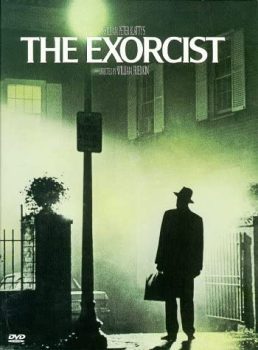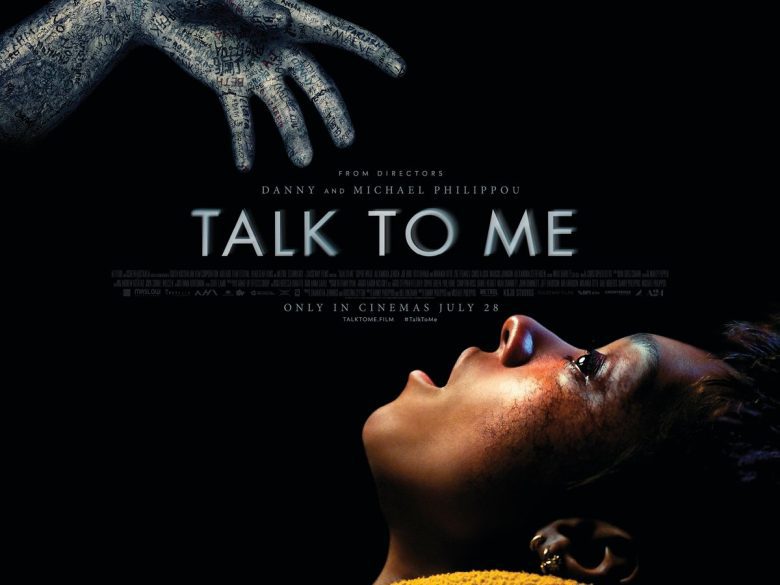by Eric Lindbom
TALK TO ME – Four Snakes
I’ve never remotely known a distribution/production company that garners the deserved fan loyalty of A24. The company’s impeccable good taste, quality control standards and marketing instincts make their every release either a must-see or at least an utterly ambitious, noble attempt from a filmmaker worth tracking.
A24 has already hugged horror by releasing the Ti West trilogy (X, PEARL and the coming MAXXINE). This summer, they’ve championed Australian director brothers Danny and Michael Philippou’s TALK TO ME (in theaters now).
It’s long acknowledged horror can ably serve as a metaphor to address weighty themes from societal ills to common worries (beyond just fear of the dark) all under the camouflage of escapist carnage. TALK TO ME, along with being a kinetic directorial debut bursting with carefully calibrated gore shock thrills, has plenty on its up-to-date mind.
The sticky premise involves an embalmed hand (housed in ceramics) of vague, dark origin. Anyone who voluntarily holds it, and mouths some set incantation lingo, is thrown into euphoric then horrid delusions, physical spams and facial make up distortions familiar to viewers of THE EXORCIST (which we’ll honor at length deeper in this piece). The rub here is momentary demonic possession (that invariably goes tragically awry) is available to thrill seekers on a voluntary basis only and the reactions are custom made for the user’s own phobias and past traumas. So the Faustian aspects of bargaining with the devil are right in the foreground.
TALK TO ME channels the dangers of recreational drug use particularly strains like acid and angel dust which effect users in radically different ways, but the bad trip at least is one you can call your own. Beyond serving as a cautionary tale about brain stomping narcotics, TALK TO ME also plugs into the ongoing obsession with social media and the desire to try anything crazy (ala Johnny Knoxville) as long as it generates likes or emoticons.
The usual hard partying rec room scenes of countless drive-in fare takes on new dread here as the teen characters are egged on to play chicken with the hand while being filmed by their chortling pals. What elevates the scenes are the actors especially Sophie Wilde as Mia who pieces together the death of her mother and soon gets addicted to the false leads the demon hand readily provides. Miranda Otto excels as well as the skeptical mom of a teen victim.
TALK TO ME features unusually unsettling sound design which was an Oscar-winning attribute of the film honored below. The camera never stops moving and the forward momentum is on over drive especially in the first half.
That said, there’s no shortage of recent horror films delivered with optimum technical panache. TALK TO ME separates itself from the pack by pulling an act of sly audience implication. We’re rooting for the peer-pressured characters to play ball with the forces of darkness and then we’re forced to witness the hard R violent aftermath of getting OUR voyeuristic wish granted A jolting, unexpected ending arrives with as much poetic justice as a classic horror short story.
As far as a franchise monster, let’s give a hand to the hand!
***
FIVE SNAKES FOR THE EXORCIST
In honor of the recent passing of Friedkin, let us acknowledge that this holiday season, THE EXORCIST celebrates its 50th anniversary. Given its influence on TALK TO ME (and all post 1973 demonic possession films), the time is right to revisit why Friedkin’s adaptation of William Peter Blatty’s novel left such a scorched earth impact.

The film gets pop culture referenced for its levitations, shaking bed and Linda Blair’s spinning noggin, pea soup puking and her pustule pocked visage (the work of makeup genius Dick Smith who transformed Brando into Don Corleone). Yet, those touchstones (imitated in other films usually to little effect) aren’t the secret sauce that captivated and/or repulsed a nation that came away scared to mess with Ouija boards (just like JAWS made others phobic over dips in the ocean.).
Effective films cause an audience to temporarily suspend disbelief and be transported to another place or time. Though seated in theaters, many contemporary audiences couldn’t help feeling the events Friedkin depicted were somehow real or could be. Friedkin masterfully turned engaged spectators into terrified rubber neckers and that’s why THE EXORCIST endures.
In his new book THE EXORCIST LEGACY: 50 YEARS OF FEAR author Nat Segaloff points out techniques Friedkin utilized in a blood chilling matter-of-fact manner to realistically depict the story of pre-teen Regan McNeil’s possession in. He worked with Owen Rolzman, a documentary cinematographer gifted at shooting up close. The film is ever in our face without many distancing medium shots. Minus Industrial Light & Magic-styled eye candy effects, THE EXORCIST brought cinema verite terror.
This hyper reality is on display elsewhere by icky medical examinations that hit home for any in or outpatient and a serious tone. Other than Blair’s startlingly brave work as the bedeviled pre-teen, the characters are adults. They act accordingly, especially Regan’s mother (Ellen Burstyn), a believably distraught though not necessarily sympathetic film star, and playwright Jason Miller in a feral performance as Father Karros who battles his own crisis of faith. The body count is stingy and free of smirking teens getting slaughtered via a numbing ritual of addition by subtraction.
Stanley Kubrick reportedly salivated over the prospect of making the movie but I’m convinced he couldn’t have bettered Friedkin’s work. No doubt Kubrick’s hypnotic sterility would have brought mind bending imagery and legions of fans but not the immediacy of Friedkin’s street level approach. While viewers of THE SHINING can dissect new layers of meaning with each screening, no one needs to see THE EXORCIST more than once to appreciate or resent its head-on-collision power on their stomachs and bowels.
Though not devoid of humor (Mercedes McCambridge voices the demon with gleeful vulgarity), THE EXORCIST, for some fan boys/girls, is more admired than warmly embraced. Even screenwriter Blatty eventually convinced Friedkin/Warner Brothers to anoint a longer cut with a more emotive tone. Though not a major upgrade over the official version, it’s somewhat more in line with the deeper characterizations in Blatty’s engrossing novel which is worth several re-reads (unlike the potboiler source material for the exponentially greater JAWS and THE GODFATHER; Puzo’s novel in particular is way too obsessed with Sonny Corleone’s penis).
Icy not hot to the touch, Friedkin doesn’t play nice to his audience any more than to his actors. He infamously fired a gun off-screen to get an appropriately scared reaction from Burstyn. Friedkin, at his prime, was a risk manager’s nightmare staging his harrowing New York FRENCH CONNECTION car chase minus proper permits and using an arsonist as an explosive expert for SORCEROR. This brutal adherence to vision explains how Friedkin helmed three straight masterpieces whatever the collateral damage.
Unlike the endless iterations of vampires, zombies and werewolves that still spur inspired riffs nationally and globally, attempts to franchise THE EXORCIST flopped. Paul Schrader and John Boorman, two auteurs, each crapped out their worst movies in futile attempts. Schrader’s DOMINION: THE PREQUEL TO THE EXORCIST is ponderous and ass busting dull (and mandated a since forgotten re-do by Renny Harlin). Boorman’s EXORCIST II: THE HERETIC ranks as laughable kitsch. (You owe it to yourself to YouTube Friedkin’s hilarious remembrances of its first audience screening; he’s racked up a lot of mileage re-telling this juicy story for good reason).
Blatty wrote and directed EXORCIST III, an obscurity with defenders (I haven’t seen it), and an EXORCIST TV mini-series lacked even a faint ripple of buzz. Burstyn is back this fall with the theatrical THE EXORCIST: BELIEVER a direct sequel to the original which at least will enable viewers to pretend Boorman’s stink bomb never detonated. However it turns out, it’s doubtful anyone will leave the theater murmuring the mantra (used to market the original ‘70s LAST HOUSE ON THE LEFT) that “it’s only a movie.” THE EXORCIST was and still is way more than that.
Eric Lindbom is a hardcore horror buff with a strong stomach, weaned on the Universal classics from the ’30s and ’40s. He’s written film and/or music reviews for City Pages, Twin Cities Reader, LA WEEKLY, Request magazine and Netflix. He co-edits triggerwarningshortfiction.com, a site specializing in horror, fantasy and crime short stories with illustrations by co-editor John Skewes. He lives in Los Angeles.







